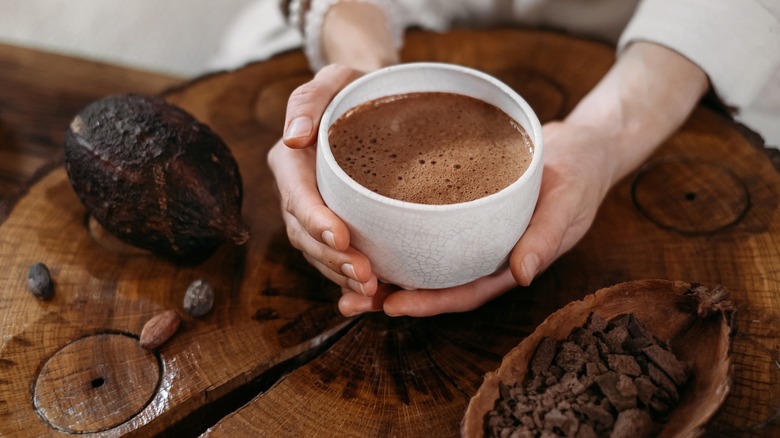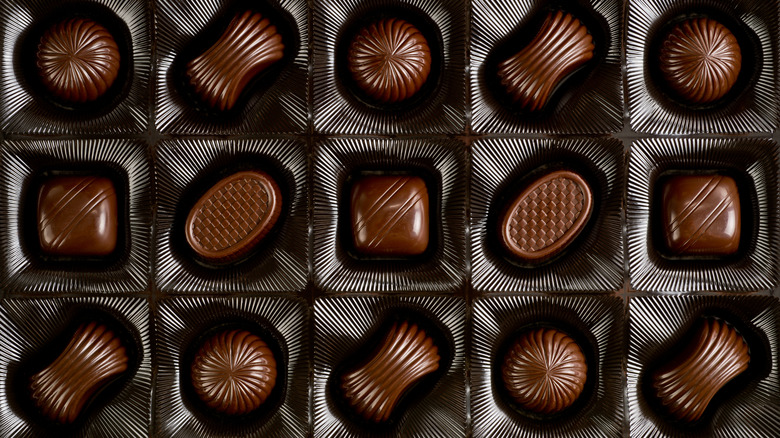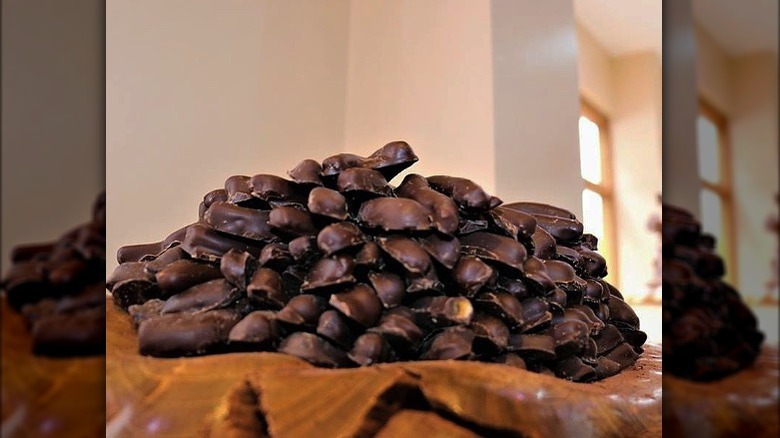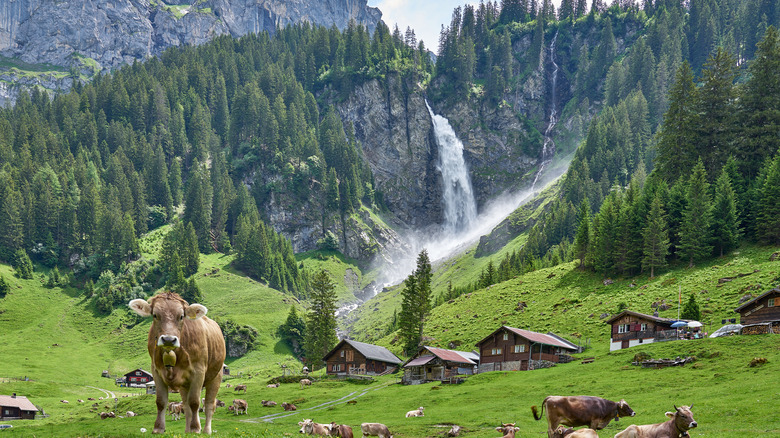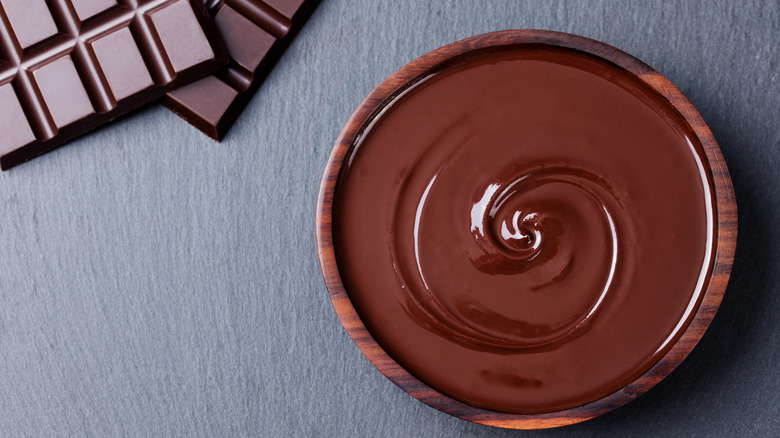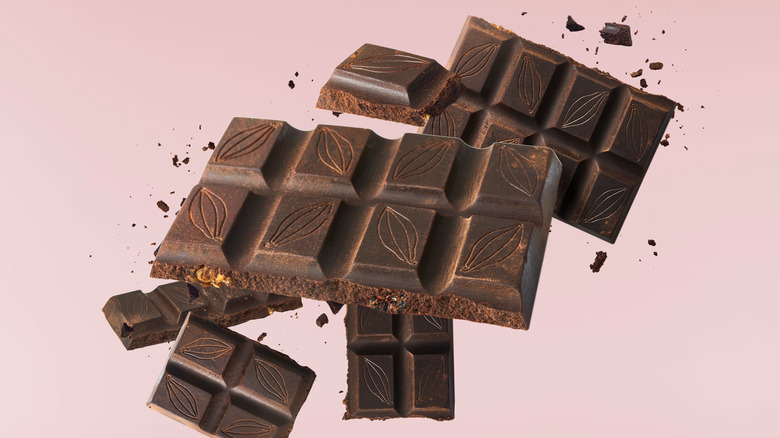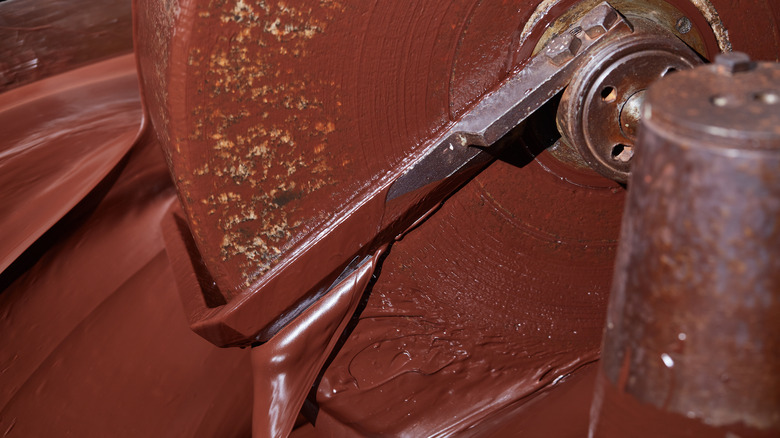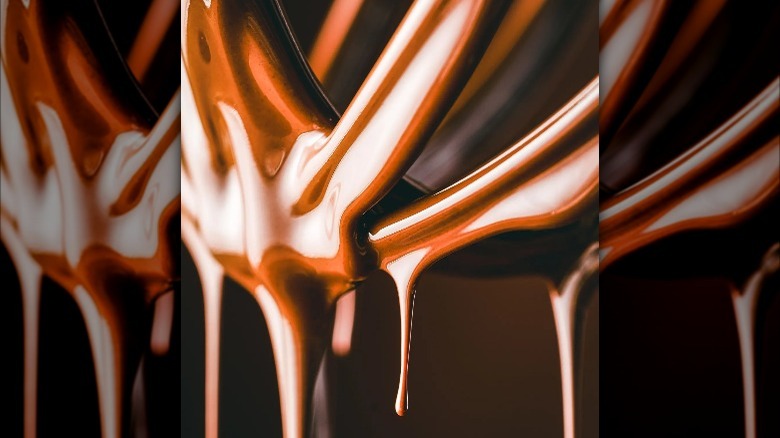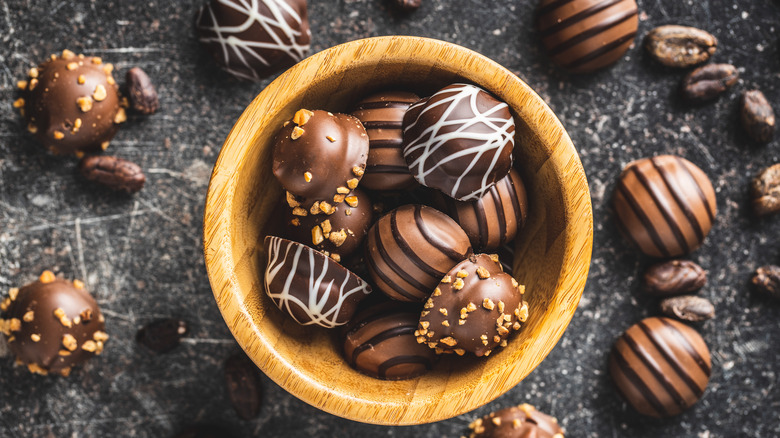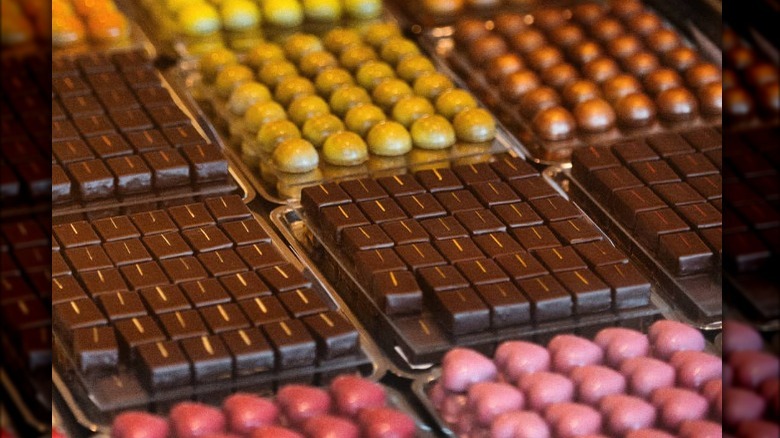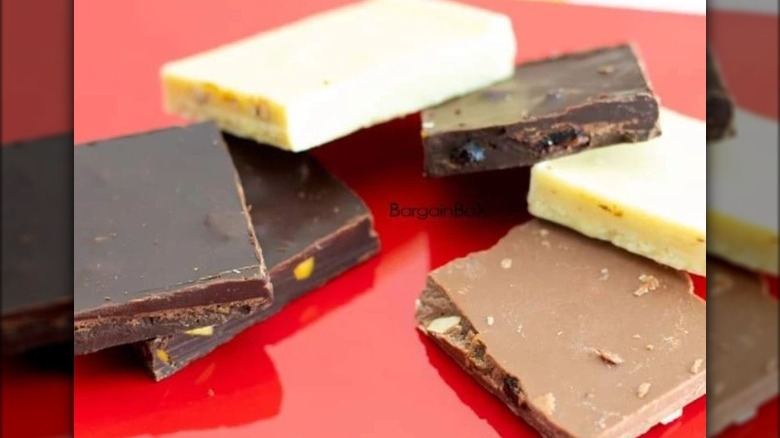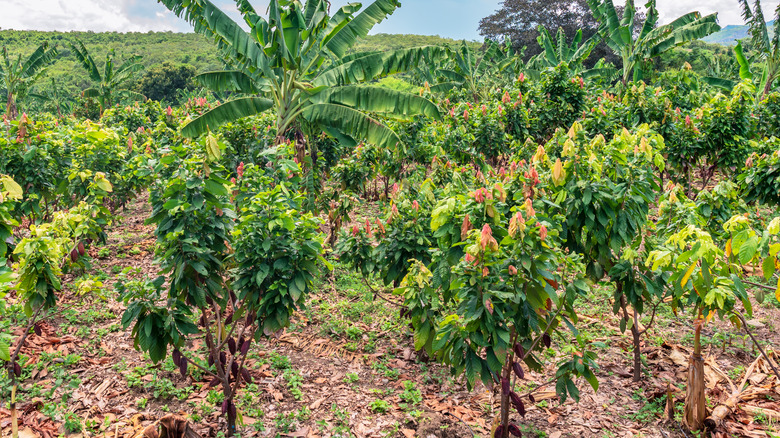Why Swiss Chocolate Is So Good
Switzerland is a small country with a lot going on. The tiny country is completely landlocked and bordered on all sides by four much larger countries: Germany to the north, Italy to the south, Austria to the east, and France to the west. Fittingly, the country speaks German, Italian, Romansch, and French, all of which are the country's national languages (via Switzerland-Tour). With so many different influences and cultures, there's a truly rich melting pot, or rather a fondue pot, of culture that combines into the one-of-a-kind Swiss culture.
With many cooks in the kitchen, it seems as if Swiss culture goes in every which way with everything imaginable, but there is an overarching element: high quality. High-quality watches, cheese, and wooden clocks, the list goes on. Of the many wonderful things that Switzerland has to offer, one of those things is chocolate. Swiss chocolate is, according to World Atlas, a world-famous luxury good. Readers who are familiar with the chocolate might equate it with a creamy, superbly sweet, and rich yet not overwhelming taste that melts right as it hits the tongue. Those who are unfamiliar may ask, well, it's just chocolate; what's all the hubbub about? Both are advised to dig in and see what exactly makes Swiss chocolate unique. It's certainly a decadent undertaking, after all.
Chocolate has an unexpectedly long tradition in Switzerland
At first glance, it doesn't make sense that Switzerland would be so involved with chocolate. Sure, chocolate is quite tasty, but being a chocolate producer is another thing altogether. Switzerland is landlocked, far from the rainforest, and unlike other European countries, like Italy and Belgium, Switzerland has no colonial ties to countries producing cacao or sugar. And yet ... Switzerland has a long history with chocolate that dates back to the early 19th century. Some, like Alpenwild, theorize that factors like strategic royal marriages and favorable trade routes eventually brought chocolate inland to Central Europe.
Be that as it may, the chocolate that floated around the 19th century probably wouldn't be palatable and would be much less recognizable to the modern-day palate. Swiss chocolate was first sold in liquid form by druggists to be consumed as a hot and medicinal drink (via Alpenwild). But this was much different from the well-known Swiss Miss drink! While inspired by Swiss chocolate drinks, Swiss Miss was created in the States by Charles Sanna, as detailed in the New York Times. Though the Swiss did first concoct Ovolmaltine, known stateside as Ovoltine (via The Spruce Eats), so there's a solid history behind a solid treat. As the 20th century came to bloom, many exciting changes were happening in Switzerland, specifically around Lake Geneva, that brought the modern-day Swiss chocolate to be.
What defines Swiss chocolate?
By the 19th century, chocolate had solidified, literally and figuratively! Swiss chocolate became its own definable Swiss concoction. But, it begs the question, what exactly defines Swiss chocolate?
First and foremost, Swiss chocolate is made in Switzerland! Of course, the cacao and sugar used for Swiss chocolate must be imported, but the chocolate itself is always made in-house, so to say. Actually, as explained by Waterbridge, legally, it can not be called Swiss chocolate unless it's produced there!
Swiss chocolate is defined as an especially creamy chocolate because it typically has a much higher milk to cacao ratio than chocolates of the surrounding area. The vast majority of Swiss chocolate is milk chocolate. In fact, according to the Centre for the Promotion of Imports for Developing Countries (CBI), dark chocolate only accounts for 35% of the multi-billion Swiss chocolate industry. The same report noted that Swiss chocolate is primarily considered a high-end luxury good. In every sense of the word, Swiss chocolate is through and through a luxurious treat.
Swiss chocolate is primarily made from Ghanaian cacao
But, of course, no cacao, no chocolate. The most important ingredient in chocolate needs to be flown in, but the Swiss are no less discerning in their ingredients. In another report from the CBI, cacao beans from Ghana took the lion's share of cacao bean imports to Switzerland, which only increased between 2014 and 2018.
Ghana is actually the world's second-largest cacao grower, and Ghanian cacao makes for a distinctive chocolate (per BBC). Ghanaian cacao is a particularly bold seed that is discernible by its distinct and earthen flavor that is balanced by a clean and smooth finish (via the C-Spot). It is, in short, cacao that makes for a distinct, complex, and flavorful chocolate.
It should also be noted that South America makes up a considerable portion of the Swiss chocolate import, accounting for about 29% of the Swiss chocolate import according to the aforementioned CBI report. By now, it should come as no surprise that the Swiss have discerning taste. The sourced cacao is not only rare but has a distinct flavor profile and is referred to as the "finest jewel" of South America (via The Development Bank of Latin America).
Using alpine milk is critical to Swiss chocolate's flavor
As described above, the creaminess of Swiss chocolate is also what defines it. This is where the chocolate-making process becomes a lot more localized. Switzerland is a part of the Alpine region that is home to many dairy farms. For a small country, Switzerland has major access to milk. The role of dairy products in Swiss cuisine is unmistakable: cheese, fondue, flammkuchen, and chocolate are only a few of the creamy goodies on the menu!
But, alpine milk is its own distinct product. One study with the National Library of Medicine found that alpine milk's fat content is much higher than other neighboring kinds of milk. The study attributes the high-quality fat to be the result of farm-feeding strategies and natural alpine grazing methods that many creameries utilize. In short, the milk used for Swiss chocolate is especially creamy and high-quality.
The abundance of milk led to a sort of ingenuity in the region. As chocolate took hold in the 19th century, chocolatiers began experimenting with the actual composition of the chocolate as well as what sort of milk could be used to concoct the best, creamiest chocolate (via Swissinfo). After all, bitterness tends to be the furthest thing from the Swiss palate. This experimentation led to a golden age of chocolate that has even defined the candy worldwide.
Switzerland became the Silicon Valley of the chocolate world by the 19th century
As discussed by Medium, by the 19th century Switzerland, specifically the Lake Geneva area, turned into the Silicon Valley of the chocolate world. What is it that made this area into a palate for the sweet treat? For one, it's where the first mechanized chocolate factory was opened in 1819 by François-Louis Cailler (via Swissinfo).
Beforehand, chocolate was largely a medicinal drink. When it was served in solid form, however, chocolate wasn't the pleasurable experience we may have in mind today. It tended to be coarser and chewier. The French-Swiss chocolatier was innovative and a dreamer. He was able to mechanize a press process that de facto created the first chocolate bar. There does remain a point of national contention between the Italians and Swiss, as Cailler had spent a large amount of time as a chocolate apprentice in Turin, where he may or may not have picked up the skills necessary for making the chocolate bar. Nonetheless, the chocolate bar made it to the factory, and the factory began producing the chocolate bar.
Half a century later, Henri Nestlé, yes, of that Nestlé chocolate brand, arrived on the Swiss chocolate scene and conveniently set up a creamery right next door to the Cailler chocolate factory. This would prove a pivotal move for chocolate as we know it (via The Chocolate Society).
The Swiss made the first solid milk chocolate bar
The neighboring chocolate factory was actually headed by Daniel Peter, the son-in-law of Callier. By the last quarter of the 19th century, the creativity surrounding chocolate was really just hitting its strides, and the innovation showed no signs of stopping. At this point in history, chocolate was still sold mainly for drinking or as a dark chocolate bar. Milk chocolate wasn't particularly commercially available at the time, as the high water content in milk spoiled the candy rather quickly (via Candy Hall of Fame).
Through a twist of fate, according to Candy Hall of Fame, Daniel Peter's wife, Lucy Cailler, was having trouble breastfeeding. Their neighbor and resident chemist, Henri Nestlé, suggested using farine lactée, or dried condensed milk, to help her feed her daughter. The dried condensed milk got Peter's wheels spinning, and he saw how this might translate to making confections. Thus, in a mere five years, through experimentation, innovation, and collaboration, the chocolate milk bar was born. Peter and Nestlé joined forces to form the Anglo-Swiss chocolate company, now Nestlé, and started selling commercially-available milk chocolate by the 1880s (via Nestlé). In this sense, milk chocolate was invented by Nestlé and is a Swiss product. Milk chocolate is synonymous with Swiss chocolate.
Swiss chocolate was among the first to melt-in-your-mouth
It's a given nowadays that chocolate melts, especially the creamy milk chocolate which simply turns to a euphoric goo the second it hits the tongue. So ubiquitous is this melting effect that Hershey's has long featured commercial's featuring the lyrics to Modern English's hit, that goes, "I'll stop the world and melt with you," per American Songwriter. But the texture of chocolate wasn't always so decadent, so to say. It took a lot of chewing to enjoy it! But, this was all about to change with no other than Rodolphe Lindt, head of the more than famous Swiss brand Lindt Chocolade.
Rodolphe Lindt, among the top chocolatiers in Switzerland, had one of those famous happy accidents in the late 1800s after milk chocolate was left spinning in the mixer over the weekend (via Zotter). Through a stroke of luck and absent-mindedness, one of the most important modern chocolate-making methods had been discovered!
This method is known as conching, derived from the French word conche or shell, referring to the shell-shaped container the chocolate was mixed in, as described by Science Direct. The process was back then a much longer one, as evidenced by the fact that it took a weekend to achieve the particular conching effect with the first batch. According to Science Direct, as much as 96 hours could be necessary to achieve conching's melting effect. But, the results are undeniable: smooth, rich, and evenly melted chocolate? Heavenly.
The innovation continues with heat-resistant chocolate
Nowadays, chocolate has become a thing of tradition in Switzerland and the world, which isn't to say that the innovative spirit that once defined the region has completely faded away. Ironic that the very country that worked so hard to get chocolate to melt in your mouth then started producing practically un-meltable chocolate in 2015 (via The Independent). Now, of course, what does non-melting even mean? In this case, a lot.
The chocolate produced by Barry Callebaut allegedly resists up to 100 degrees Fahrenheit. Right now, this doesn't mean so much for the everyday chocolate lover. It's really the chocolatiers that are being kept in mind! If the chocolate doesn't melt, chocolatiers in warmer climates can do their thing without worrying about melting, heating, cooling, and then reheating all of which might change the structure, taste, and mouth-feel of the baker's chocolate (via Confectionary News). While this doesn't quite spell out heat-resistant consumer chocolate, it does seem to still be on the horizon. As recently as 2020, Mars released another heat-resistant chocolate for the individual chocolate enthusiast. Until larger roll-outs, do mind keeping chocolate bars out of warm spots, pockets, and purses! It's certainly no treat having to clean a chocolate stain without having enjoyed the chocolate yourself.
Switzerland has the highest chocolate regulations in the world
The high standard of quality that the country holds it to could be what makes Swiss chocolate so good. Switzerland has, in fact, some of the highest regulations for chocolate in the world (via CBI). But what does that mean exactly? The report notes that it mainly has to do with the techniques surrounding chocolate making. Swiss chocolate, for example, must use specific techniques to refine it and give it a particularly smooth and melting finish. Though don't be fooled, as the report notes, finer quality cacao beans are favored by Swiss manufacturers, and even harvesters are encouraged to seek out the best of the best. From top to bottom, from tree to packaging, Swiss chocolate focuses on refinement in one way or the other.
Though not necessary, as the report describes, it is common for Swiss chocolate to exercise quality management. A specific board, the Chocosuisse, maintains a watch and quality control over Swiss chocolate. As they noted in their online book, Chocology, Swiss chocolate represents high quality. As the book notes, there is a legacy to uphold with Swiss chocolate. With such a tradition of innovation and quality, no wonder that the Chocosuisse is so protective of maintaining the good in Swiss chocolate.
Swiss chocolate is fully integrated into Swiss culture
That being said, as much as Swiss chocolate is regulated, it's also cherished in Switzerland. After all, Swiss people make up the largest consumers of Swiss chocolate (via CBI)! Statista shows that the average Swiss person eats around 8.8 kilograms of chocolate per year. This translates to about 17, almost 18 pounds! Per person! Per year! That truly is an appreciation. Maybe love is the secret ingredient. After all, there's certainly enough going around for this dessert.
In 2022, Geneva, the home of so many of the other innovations, still has a trick or two up its sleeve. One of which being the Choco Pass (via Matador Network). Life really is straightforward sometimes, and the Choco Pass is exactly what it sounds like: a ticket into seven of Geneva's most upstanding chocolatiers. Once validated by entering the first chocolatier, anyone with a Choco Pass can go into any of the seven storefronts, like the one pictured above at Favrager, and indulge in very generous samples of the store's yummy wares. All the while being introduced to both the culture and the history surrounding the treat. Maybe there is such thing as being able to satisfy the sweet tooth.
Swiss chocolate can still be a local undertaking
Though dominated by mega-brands, there is still an important (and even inspiring) role that smaller chocolatiers play. Swiss chocolate is, after all, Swiss, and locales and regions have just as much a part to play in concocting the confection. When diving into chocolate regionalism, it's good to take Alpenwild's heed and differentiate between chocolate makers and chocolatiers. Chocolate makers are those who take the beans and make them into bars, while chocolatiers are those who turn these chocolate bars into chocolate goods. One would be remiss to miss both local chocolate makers and chocolatiers.
Chocolatiers are typically the store where one goes to buy the treats, and that can be an experience in itself. In fact, one lecturer was so enamored with the Swiss chocolaterie experience that she sought to introduce the experience to Kenya (via Business Daily). Bringing the chocolaterie to Nairobi was difficult heat-wise. But, after lecturing in a small village in Switzerland, founder Lucy Grace knew the cosmopolitan Nairobi would delight in a Swiss-styled chocolaterie. And what makes the Swiss chocolaterie experience? To paraphrase Grace, craftsmanship, high quality, and an atmosphere that invites indulgence. It doesn't get much sweeter than that.
The next step is towards fair-trade and sustainable Swiss chocolate
There's always room for improvement. For the last few years, at least, there has been article after article, report after report describing the less than ethical practices and structure of the chocolate industry. Reports of Nestlé and child exploitation, labor, and slavery, critiques of the current cacao import and export model reflecting old colonial structures (via The Conversation), and of course, the question of chocolate in the face of the changing climate, according to JSTOR Daily, are just a few of the controversies. These topics reflect in the market and shape the good! As consumers focus more on fair trade, the ethics of the supply chain, and environmental implications, brands are beginning to react and adapt.
The same Barry Callebaut that is tinkering with heat-resistant chocolate has also launched a three-year "Forever Chocolate" plan to ensure sustainable and environmentally-conscious chocolate, including farming practices that ensure this. It does beg the question, does it change criticism of colonial practices when European countries such as Switzerland control sustainability standards even in cacao-producing countries? Furthermore, considering that the BBC notes a large grievance of Ghana, discussed above as the largest exporter of the cacao to Switzerland, is receiving $10 billion of a $100 billion industry, do sustainability measures address the price discrepancy? But, as Swiss companies take measures to address these concerns, as well as child slavery concerns (per Reuters), there is hope for a more sustainable, more equitable future.

